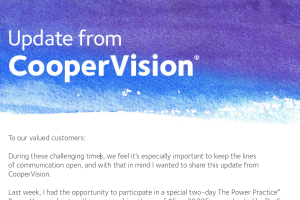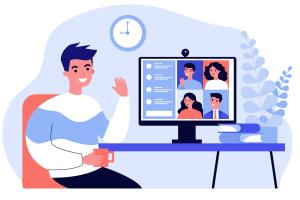In this segment of “For Your Practice” we wanted to share some ideas on what you can do now to prepare for reopening your practice. While it might be hard to imagine that day at this point, it will come, and how you prepare over the next weeks will impact the success of your practice for the remainder of 2020 and into 2021. In fact, preparing now for your practice reopening was the advice of many industry leaders interviewed in two recent power hour segments hosted by Dr. Gary Gerber (you can hear the recorded webinars at https://powerpractice.com/power-hour/).
To give you more ideas for planning for practice reopening, we’re excited to offer a perspective from Dr. Maria Sampalis on what steps she is taking now to reopen her practice.
Dr. Sampalis has over 12 years of practice experience in both private and corporate optometry settings, and she currently practices at ForEyes in Cranston, Rhode Island.

Why do you think it’s important to plan now for practice reopening even when it’s uncertain when practices will be able to reopen?
You have time now to review and prepare. By doing this you can better prepare for uncertain circumstances when they come up. Being as prepared as possible will help lower your stress level when the time for reopening comes and help make you and your practice more resilient to unexpected changes. Patients will return and so it will be important for you to be on top of your game to welcome them back to your practice.
What steps are you currently taking to plan for reopening?
I go into the practice whenever I’m able to, usually on weekends. I continue to keep the practice clean and tidy. I’m actively working to stay on top of my EOB and denied claims and to follow up on payments due from the insurance companies. This is what I can do currently to help my cash flow. I’m also continuing to market my practice and make sure patients know that I’m available for emergencies.It’s easy to use *72 to forward your practice phone to your home cell phone.I’ve also let my patients know that I can still help them order replacement spectacles if needed or additional contact lenses.I find that being active and keeping my practice reopening in mind helps me keep a positive mindset.I’m also currently looking at telemedicine options that might be able to help me assist patients with non-urgent needs.
What steps do you think will be critical to take when we’re two weeks out from reopening?
We should reach out to patients and notify them that we’re coming close to reopening. It will also be important to clean the office thoroughly according to the new safety standards. Patients will expect a high level of hygiene when they come back to help them feel safe. We should be sure we’re prepared with the proper PPE and have communicated that to our patients.
In some of our other interviews you talked about the importance of patient retention. Are there any steps you’re taking currently to aid with patient retention even when you can’t physically see patients in your practice?
It’s important to continue to market your practice just like you would be when open. This helps you stay top of mind with your patients. I’ve been focusing on sending them relevant information that’s important to them. For example, communication around contact lens safety and proper hygiene with spectacles. Although they might be able to find this information on their own, I believe it’s more meaningful coming from their doctor. Your patients trust you and consider you an expert, and that makes the knowledge you share more impactful than what they find on the internet. I believe we should always strive for year-round contact with our patients, not just around exam time. I’m continuing to send out my e-newsletter. This can be simple and concise, maybe something that takes just 5 minutes to create, but it helps patients keep your practice top of mind.
Recent Jobson polls (https://jobsonresearch.com/coronavirus-ecp-study-wave-5/) indicate that ECPs are becoming more interested in telehealth options to provide healthcare to their patients during this time.
Were you using telemedicine before the COVID outbreak, and, if so, have you seen a further increase in interest in telemedicine from your patients now that in-person eye care visits are not possible?
I wasn’t using telemedicine prior to the COVID outbreak, but I’m now considering leveraging it to increase my availability to help patients. In my research, I’ve found that with some EMR systems, telemedicine is available for free during this time. In my own networks, like the Jobson survey found, I’m also finding that doctors are becoming more open to telemedicine as a supplemental option for care. Patients are also becoming more interested in telemedicine due to the shelter-in-place orders. They’re becoming a lot more exposed to it through their primary care physicians as a way to avoid waiting rooms and the potential to avoid interacting with other sick patients.
In addition to planning for reopening, how else have you been leveraging the current downtime to make your practice stronger once things are back to normal?
I’ve been applying for the new SBA loans to ensure cash flow and take the financial stress off. Note: There are excellent AOA webinars that talk through the details of these loans and answer many questions you might have about the application process at https://www.aoa.org/coronavirus. Of course, like many folks out there, I need to balance my home reality with what’s possible to do. Like many other optometrists out there, I’ve also become a part-time teacher to my children. When I do have free time, I do what’s possible online and keep caught up on administrative tasks for my practice. Most importantly, I’m focusing on staying mentally calm and relaxed to build up resiliency for when things get busy again.








